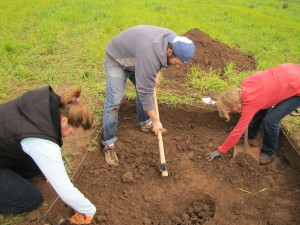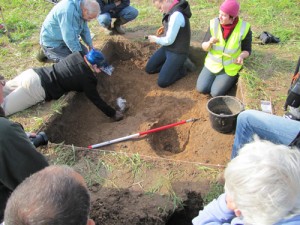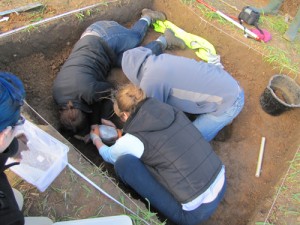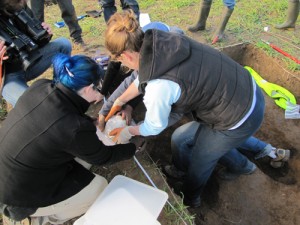In late September Laura McLean (Essex FLO) was contacted by a landowner who had given permission for a metal detectorist to search on his land. He had said that a few interesting objects had turned up, and could he bring them in for examination. Well, a few interesting objects actually turned out to be a lot of metal work, forming a Bronze Age Hoard. The landowner and the detectorist Mr J Humphreys brought the objects into Colchester and Ipswich Museums to be examined and reported under the Treasure Act.
Mr Humpreys was on holiday in Essex when he made the discovery. About a week later, Laura was contacted by three Essex based metal detectorists who also had permission to detect on the same land. Mr W Hill, Mr C Mann and Mr G Starr had recovered even more Bronze Age material from the same area as the original find.
Whilst recovering the metal work, the three detectorists discovered part of an in situ pottery vessel associated with the metalwork. Running their detectors over the visible rim of the pot, it was clear there was more metalwork to be retrieved, but knowing that this was in its original undisturbed Bronze Age context, the finders made the decision to back fill the hole (after a few photos!), leaving the pottery and remaining metalwork where it was. They called Laura McLean for advice, who began to plan an excavation.
In early October, Laura McLean, Kate Orr (assistant FLO) and three members of the Treasure Team, Ian Richardson, Janina Parol and Caroline Barton joined the landowner and four metal detectorists to excavate the known area of the hoard.
A 2 meter square trench was excavated with the help of the detectortists to find the remaining metal work concentrations and to locate the pottery vessel. Once the area marking the pot was reached, a careful excavation around the vessel began.

Excavating the hoard area
Unfortunately the plough hadn’t left the pot untouched. The vessel was clearly damaged and partly missing on one side, and there were clear fractures on the side that was more intact. The vessel had also slumped slightly to one side.
So a fragile, fractured pot, full of very heavy metal work. Decision time – should we excavate the vessel and contexts on site, or block lift?
As the chance to excavate an in situ hoard is so rare (as most reported are out of context in the plough soil) and the fact there is pottery involved makes it even more unusual, we made the decision to block lift as this would allow us to get the maximum amount of information about the deposit. This would also give us the opportunity to x-ray the vessel back in the lab, giving us a clearer understanding of the order objects were deposited in the vessel.

Wrapping the pot in clingfilm!
So, out came the cling film to hold the pot together whilst we dug around it and undermined it so that it could be lifted. This was a rather slow and painstaking process, making sure the vessel was supported whilst digging around it. Eventually the vessel was ready to be lifted, and for rather a small pot it was bloomin heavy with all the metalwork inside!

Excavating the pot

Lifting the pot
Work continues on the hoard at Colchester & Ipswich Museums…